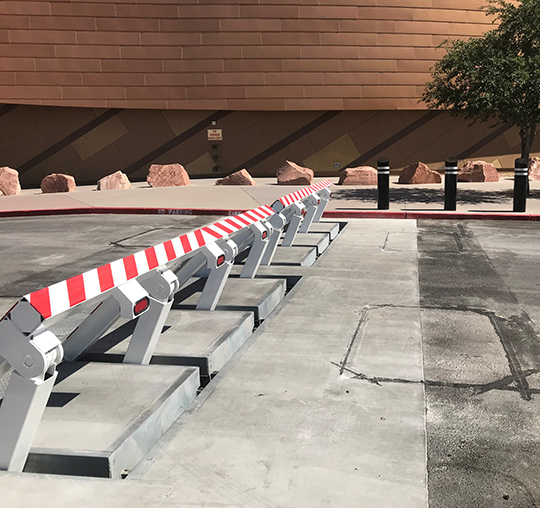Facts About Wedge Barriers Uncovered
Table of ContentsNot known Details About Wedge Barriers Indicators on Wedge Barriers You Need To Know


18 may be done quicker, quickly, and cost effectively. FIG. In particular embodiments, the support 30 might be a steel framework including plates, beams(e. g., I-beams ), and/or various other structures that are protected within the structure 14, which may be concrete. At the surface 12, a top side 28 of the anchor 30 might be at the very least partially subjected
, consequently allowing the attachment of the obstacle 10 to the anchor 30. g., threaded openings)in several beam of lights or plates of the anchor 30 might be exposed to the surface 12. In this manner, bolts 32 or other mechanical fasteners might be used to protect the barrier 10 to the anchor 30. As the barrier 10 is placed to the surface 12 of the structure 14, collection of debris and various other material under the barrier might be minimized, and parts of the bather 10 may not be subjected to listed below grade environments. As indicated by recommendation numeral 52, the training device 50 includes parts got rid of under the wedge plate 16. As an example, the parts 52 underneath the wedge plate 16 may include an electromechanical actuator, a webcam, one or more cam surface areas, etc. Additionally, the training device 50 consists of a springtime assembly 54
The spring pole 58 is combined to a cam(e. g., camera 80 displayed in FIG. 4) of the lifting mechanism 50. The springs 60 disposed concerning the springtime pole 58 are kept in compression by springtime supports 62, consisting of a dealt with spring assistance 64. That is, the fixed springtime support 64 is fixed family member to the structure 14 et cetera of the bather 10.
Not known Factual Statements About Wedge Barriers
g., springtime assistance 65 )may be repaired to the end of the spring rod 58 to enable compression of the springtimes 60. As the springtimes 60 are compressed in between the spring supports 62, the springtime setting up 54 generates a pressure acting upon the cam combined to the spring rod 58 in a direction 66. As an example, the staying force put on
the webcam to deploy the wedge plate 16 may be offered by an electromechanical actuator 84 or various other actuator. Therefore, the spring assembly 54 and the actuator 84(e. g., electromechanical actuator)might run with each other to convert the web cam and raise the wedge plate 16.
As discussed above, the springtime setting up 54 applies a constant force on the camera, while the electromechanical actuator might be controlled to exert a variable pressure on the cam, therefore enabling the training and lowering( i. e., deploying and pulling back )of the wedge plate 16. In specific personifications, the continuous force used by the springtime assembly 54 might be adjustable. g., electromechanical actuator) is impaired. As will be valued, the spring setting up 54 may be covered and shielded from debris or various other components by a cover plate(e. g., cover plate 68 received FIG. 4) that may be substantially flush with the elevated surface area 38 of the structure 14. As stated over, in the released placement, the wedge plate 16 offers to block accessibility or travel past the obstacle 10. The barrier 10(e. g., the wedge plate 16 )might block pedestrians or lorries from accessing a residential or commercial property or pathway. As discussed above, the obstacle 10 is connected to the support 30 secured within the foundation 14,

front brackets 71. As a result, the affiliation settings up 72 might pivot and turn to allow the collapse and extension of the link settings up 72 during retraction and implementation of the bather 10. The link settings up 72 cause movement of the wedge plate 16 to be limited. For example, if a vehicle is taking a trip towards the released wedge plate 16(e. For instance, in one condition, the safety and security legs 86 might be extended duringmaintenance of the barrier 10. When the security legs 86 are released, the security legs 86 sustain the weight of the wedge plate 16 against the surface 12. Consequently, the lifting device 50 might be shut down, serviced, eliminated, changed, and so forth. FIG. 5 is partial viewpoint sight of an embodiment of the surface-mounted wedge-style obstacle 10, showing the cam 80 and the cam surface areas 82 of the training device 50. Especially, two cam surfaces 82, which are referred to as reduced web cam surface areas 83, are positioned listed below the webcam 80. The lower web cam surface areas 83 may be fixed to the surface 12 (e. For example, the reduced camera surfaces 83 and the installing plate 85 might create a solitary item that is safeguarded to the anchor 30 by bolts or other mechanical bolts. Additionally, two cam surfaces 82, which are referred to as top web cam surfaces 87, are placed view website above the web cam 80 and combined to (e. In various other embodiments, intervening layers or plates may be placed between the surface area 12 and the lower web cam surface areas go right here 83 and/or the wedge plate 16 and the top webcam surfaces 87 As pointed out above, the cam
80 converts along the web cam surface areas 82 when the wedge plate 16 is raised from the retracted position to the deployed setting. In addition, as mentioned above, the spring setting up 54 (see FIG. 3 )may provide a force acting on the webcam 80 in the direction 102 using spring rod 58, which might minimize the force the electromechanical actuator 84 is required to use to the cam 80 in order to activate and lift the wedge plate 16. 1 )to the deployed placement(see FIG. 4). As revealed, the camera 80 consists of track wheels 104(e. g., rollers), which get in touch with and translate along the camera surface areas 82 during operation.